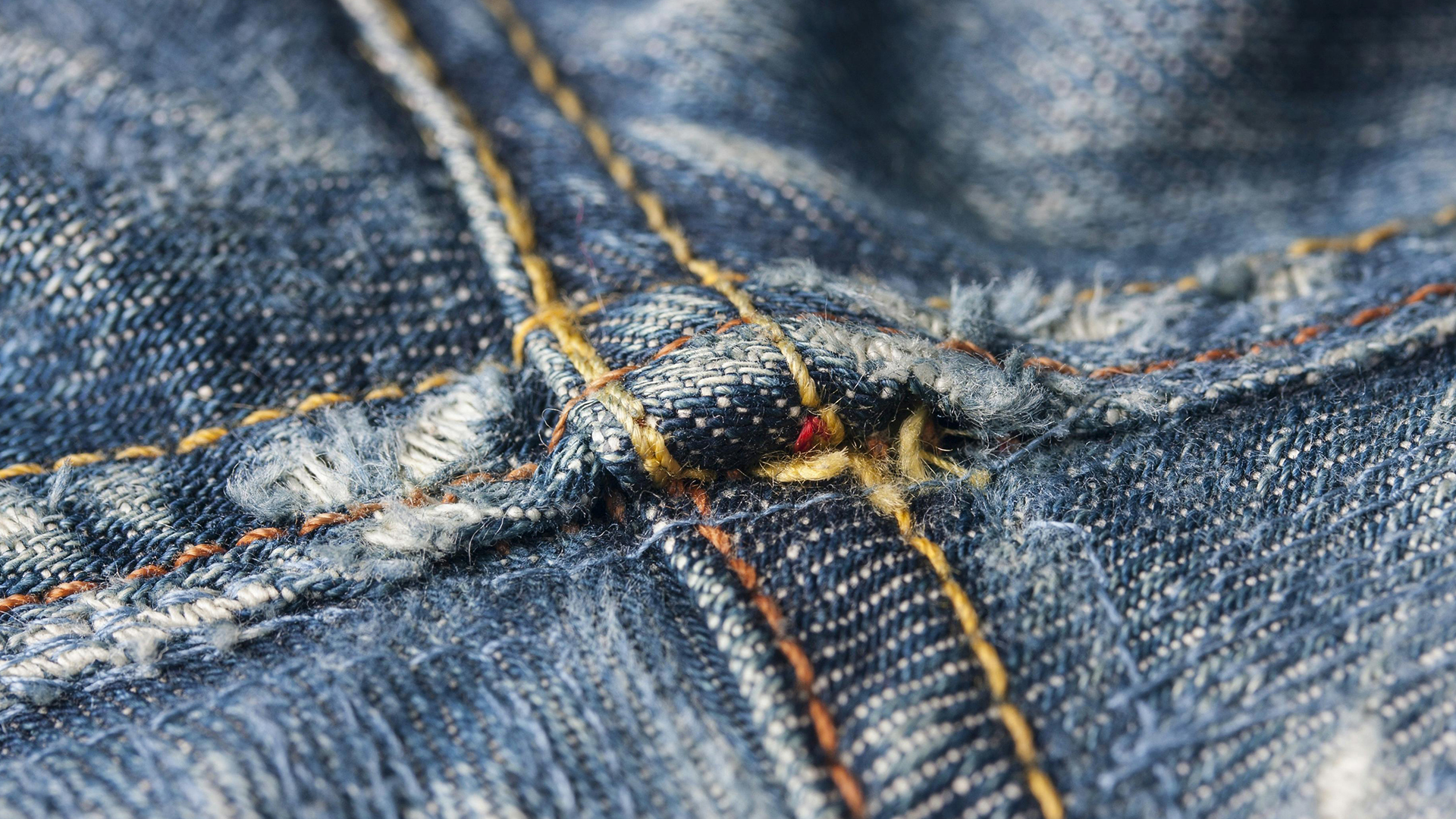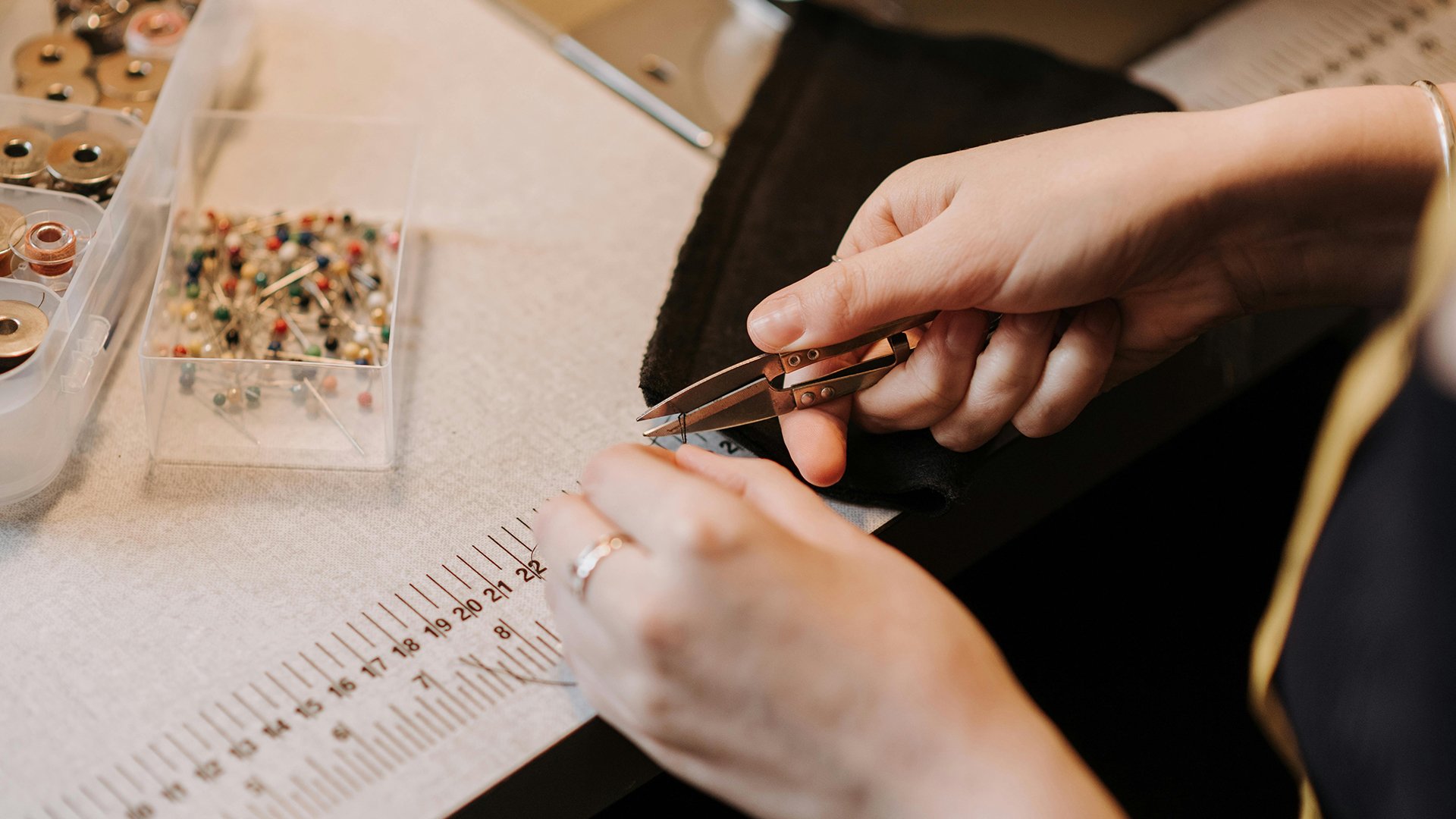REPAIR
Renew your damaged or broken textiles
1.
Short introduction
2.
A deeper dive into
REPAIR
3.
Quick Wins & Challenges
4.
Now you come into play!
1.
Short introduction
REPAIR is how you can make your damaged clothing wearable again!
Repairing keeps our textiles alive and in top shape! Discover below why you should mend your clothes yourself and elevate your DIY skills!
WHEN SHOULD WE REPAIR?
This option is ideal for garments that you want to continue wearing or pass on to others, but which have lost some of their functionality, be it through holes, tears, lost buttons, or broken zips. Instead of throwing them away, it's time to REPAIR!

2.
A deeper dive into
REPAIR
REPAIR makes it possible to keep our clothes in top shape without constantly buying new items! Dissatisfaction with their condition is one of the main reasons why textiles are discarded (37%). Yet more than three-quarters of these textiles could be repaired. Holes, broken zips, or buttons that have fallen off are no reason to throw garments away. There are simple techniques and support services for repairing clothes and shoes.
Here, we explore techniques for repairing textiles and provide a bit of background information on the associated social, ecological, economic and political aspects. If you want to learn the best ways to REPAIR your clothes right away you can jump straight to our tips.
TECHNIQUES
Do you think repairing is only for professionals? Then you're in for a surprise! Small repairs can often be done in a few simple steps without any specialist knowledge. So don't be afraid of your first repair and ask friends and family for advice if you're unsure.
A stitch in time saves nine: try to spot thinning areas in the fabric, loose buttons, or jammed zips early on. Once the damage gets worse, the repair will become more time-consuming.
A few tools around the house are useful for carrying out repairs easily. Scissors, a needle, and thread are standard equipment. Over time, you can accumulate a small supply of wool scraps, fabric remnants, buttons, and yarns in different colors and qualities. You can also look for useful materials at flea markets. Sometimes spare buttons or yarn are included when you buy new clothes. Check the inside of the care label or in a bag attached to the price tag and keep everything together in a box.
A tape measure and ruler, textile pins, pins, an embroidery hoop, and an iron are also useful. To be prepared for small problems while on holiday, it is best to take a travel kit with sewing utensils such as needles, thread, scissors, safety pins, and mending fabric.
And now it's getting practical!
There are two basic approaches to repairing textiles: mending and darning.
Mending is particularly suitable for woven, less stretchy fabrics. A piece of fabric (patch) is attached over or under a hole. When choosing a patch, make sure that it has a similar stretch to your garment.
With darning, a new fabric is produced to fill a hole or to reinforce a thin area. This method is particularly suitable for knitted clothing. You can also sew on buttons and repair zips relatively easily at home.
If an item of clothing no longer fits perfectly, small alterations can often help to adjust the fit as opposed to discarding the garment.
With a little skill, you can make small alterations and repairs yourself. Take a look at our tips! Alternatively, you can turn to alteration tailors or a repairing & sewing café. Here, you'll find the tools and support you need for your first repair.
Damaged or broken textiles are still valuable. Either by yourself at home or together with others, you can unleash your creativity and bring your clothes back into your life!

FACTS
According to the Ellen MacArthur Foundation, repairs could extend the life of a garment by 75 % while reducing carbon emissions by 30 %.
ENVIRONMENTAL
Since 2020, man-made things have weighed more than all living things on earth. This could even triple by 2040 (2). Excessive use of non-renewable resources is putting our ecosystems under severe strain. This leads to biodiversity loss, a decline in ecosystem services such as air and water purification, deteriorating soil quality, and threats to human health.
Repairing is a responsible way to use existing resources because it renews the value of our clothes. We can minimise the new materials required to meet our need for functional and attractive clothing by focusing on repairing instead of buying new.
SOCIAL
By repairing clothes, we show appreciation, both for the people who made them and for the natural resources required for their creation. When something breaks, we often don't know how to fix it, but more than that, we don't see the need to fix it. Due to the availability of cheap, low-quality fast fashion, repairing is often seen as an unnecessary and tedious activity.
In our society, repairing is still often viewed negatively, as it is associated with a time of scarcity and poverty. Since the 1950s, the repair of clothing has gradually lost importance in many parts of the wold. Increasing economic prosperity and the availability of cheap clothing have been accompanied by a loss of basic knowledge about textile techniques, quality, and production.
Repairing is not an old-fashioned or romantic idea, but should be a natural part of our everyday lives. Give it a go and you will realise how much joy and feelings of self-efficacy a successful repair can inspire!
FACTS
1060 repair cafés are now listed in Germany on the “Reparatur-Initiativen” platform.
ECONOMY
Repairing your clothes is easy on your wallet. Repairs can often be carried out easily and inexpensively at home, eliminating the need to buy a new item of clothing. For more complex problems, repair services such as alteration tailors or shoemakers are a good place to go. It’s important to support local repair services. Independent repair services can only survive long term and pass on their craftsmanship expertise with the support of customers. The preservation of knowledge is important, as expertise in the industry is increasingly being lost due to a lack of young talent.
Have you ever bought a new piece because it was more practical and not much more expensive than a REPAIR?
Unfortunately, an awareness of textile craftsmanship has been lost because fashion is offered so cheaply and we have limited connection to its production. A complex REPAIR requires craft and analytical skills as well as creativity. A repair service will take a close look at your garment. As their prices cannot keep up with the low prices of the linear economy, it is a major economic challenge for repair services to survive because they are not competitive.

FACTS
More than half of German consumers want to repair to save money, while 48 % want to extend the life of their possessions, 35 % want to reduce their environmental impact and 33 % want to cut down on unnecessary consumption.
POLITICS
People are key to supporting local repair services, but we are often stuck in the fast fashion system. To encourage more conscious consumption, we also need political support, which plays a crucial role in promoting more sustainable consumption.
An important step was the European Parliament's approval of a "right to repair" directive in April 2024, which aims to guarantee that manufacturers must repair their products where possible. Currently, the regulation mainly covers electronic products (5). However, it can be assumed that the "right to repair" will also apply to clothing when the rules for the reparability of textiles are drawn up as part of the ecodesign regulation.
Meanwhile, countries such as Belgium, Sweden, and Portugal are showing us how repairing products can be made more attractive by reducing VAT on small repairs to items such as textiles, shoes, leather goods, and bicycles (6). In France, a repair bonus for textiles was introduced in October 2023, allowing consumers to reclaim part of the repair costs for clothing and shoes at participating workshops (7).
Through collective action by politicians, civil society, and businesses, we can create a culture of repair and bring about positive change in the fashion industry.
3.
Quick Wins & Challenges
CHALLENGES
- Have you never had a needle and thread in your hand and are unsure about making things worse? Don't worry! In sewing courses or repair cafés, you can learn the basic stitches and practice step by step. Sewing is easier than you think!
- Visible repairs can affect the resale value of products, but repairs can also be useful when it comes to reselling clothing. If you want to pass on your product repaired, then also look for "invisible" repair methods.
- Some fashion brands now also offer a repair service. Before you send your clothes to a fashion label for repair, check whether there is also a local repair option. Shorter distances are often better for the environment.
- Repair services sometimes seem more expensive than buying new, but that shouldn't be a reason to throw your clothing away. Repair cafés are a cheap alternative to repair shops. There you have access to materials, tools, and expert advice to carry out repairs yourself.
QUICK WINS
- If you repair things yourself, you can save money, as the materials and effort involved in many repairs are kept to a minimum, especially if you don't have to buy the materials for the repair yourself.
- When repairing, you can personalise your items and make them even more valuable to you.
- You will see how satisfied you are after you have repaired something with your own hands and made it functional again.
- It's fun to get creative with mending and darning.
- Repairing teaches you a lot about the construction of your clothes and over time you will gain a better understanding of how to repair damage quickly.
- You'll be doing your bit for the environment by using your clothes for longer instead of buying new ones.
4.
Now you come into play!
1. Try out our DIY tips
Ready to get started? Then grab a needle and thread and get started! Discover video tutorials, articles, and books in our e-book to learn how to REPAIR yourself. Do you prefer to REPAIR together? Then take a look at our tips for group repair meetings.

2. Find a local service
MAP & GUIDE
For a perfect repair, it's worth going to a local repair service! There you can discuss your ideas in person, ask any questions you may have, find out about the price of the repair, and discuss whether you want the repair to be visible or invisible. Different products and materials require different machines and services, so check in advance to see what services are available in your area.
You can use our GUIDE or our MAP to find services in your area and filter them according to your needs. Search for alteration shops, leather and fur work, brands with repair services, repairing and sewing cafés, and places that offer shoe and bag repairs.

